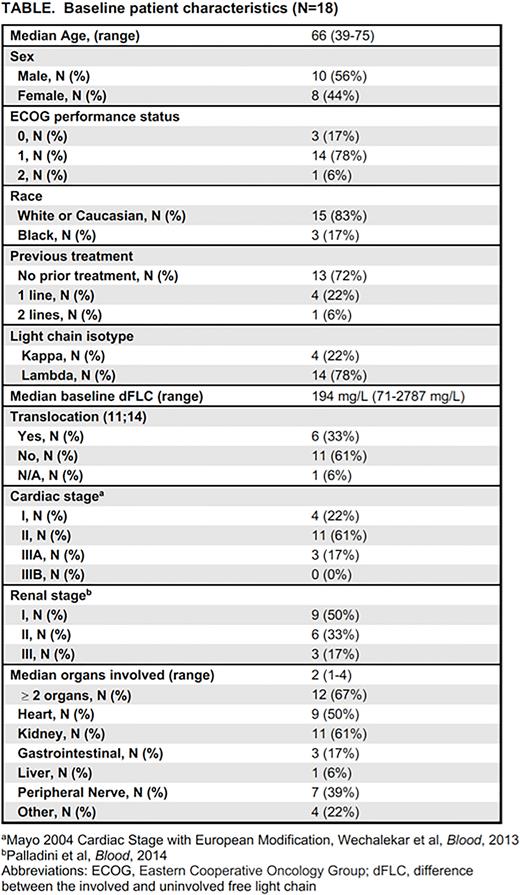Abstract
Background: Systemic light chain (AL) amyloidosis is a rare disease that is characterized by the tissue deposition of misfolded protein aggregates, leading to progressive organ dysfunction and significant morbidity and mortality. Novel therapeutic combinations with improved safety, tolerability, and efficacy profiles remain a paramount need. We herein report initial results of a phase 1 investigator-initiated study evaluating the safety and preliminary efficacy of the novel combination of the anti-CD38 monoclonal antibody (mAb) daratumumab, the oral proteasome inhibitor ixazomib, and dexamethasone (DId) in AL amyloidosis (NCT03283917).
Methods: This phase 1, single center, open-label study enrolled AL amyloidosis patients (pts) who were either treatment naïve or previously treated with evidence of clonal relapse or with refractory disease defined as less than a hematologic very good partial response (VGPR) to prior therapy. Key exclusion criteria included NT-proBNP ≥8500 ng/L, clinically overt myeloma (hypercalcemia and/or bone lesions), and previous ixazomib or anti-CD38 mAb therapy.
Treatment was administered on a 28-day cycle for up to 12 cycles with daratumumab weekly x 8 weeks, then every other week x 16 weeks, and then every 4 weeks thereafter. Daratumumab was initially administered intravenously (16 mg/kg) but later changed to subcutaneous injection (1800 mg) with a protocol amendment. Ixazomib was administered orally 4 mg on days 1, 8, and 15, and dexamethasone administered 20 mg weekly for cycle 1 and increased to 40 mg weekly for cycle 2 and beyond depending on patient tolerance. The primary study endpoint is to confirm the safety and tolerability of DId in AL amyloidosis. Key secondary endpoints include hematologic response rate and organ (cardiac and renal) response rates. Planned enrollment is 20 pts with toxicity monitoring in cohorts of 5 pts.
Results: A total of 18 pts have been dosed to-date including 13 treatment-naïve pts and 5 previously treated pts with a median of 1 prior line of therapy. Baseline characteristics are summarized in the Table. Median age was 66 (range 39-75), 8 (44%) pts were female, and 3 (17%) pts were Black. Median baseline difference between the involved and uninvolved free light chain (dFLC) was 194 mg/L (range 71-2787), and 6 of 17 (35%) pts with available FISH testing had t(11;14). Median number of organs involved was 2 (range 1-4), including 9 (50%) pts with cardiac involvement and 11 (61%) pts with renal involvement.
Overall hematologic response rate (≥PR) on treatment was 100%, ≥VGPR rate 72%, and complete response (CR) rate 11%. Cardiac response rate was 43% among 7 response evaluable pts (baseline NT-proBNP ≥650 ng/L), and renal response rate was 36% among 11 pts. Among 5 previously treated pts, there were 4 hematologic VGPRs and 1 hematologic CR. The median number of DId treatment cycles was 8.5, with 7 (39%) pts completing all 12 treatment cycles, and treatment is ongoing in 3 (17%) pts. Intent to proceed with high dose chemotherapy and autologous stem cell transplantation was the most common reason for early treatment discontinuation (4 pts, 22%).
The most common treatment emergent adverse events (TEAEs) of any grade regardless of attribution were anemia (56%), thrombocytopenia (56%), dyspnea (56%), fatigue (56%), hypoalbuminemia (56%), and nausea (56%). The most common grade 3 or 4 TEAEs (≥20%) were lymphopenia (33%), lung infection (22%), and thrombocytopenia (22%). Treatment emergent peripheral neuropathy (PN) was 28% (all grade 1 and 2), among whom 4 of 5 pts had baseline amyloid PN, other PN, and/or prior bortezomib exposure. There were 3 deaths on study, all unrelated to treatment (1 related to post-operative complications from small bowel obstruction due to congenital Meckel's diverticulum, 1 related to progressive hepatic amyloidosis, and 1 related to pulmonary embolus in setting of COVID-19 infection).
Conclusion: Treatment with DId in both newly diagnosed and previously treated AL amyloidosis pts is safe at standard doses of daratumumab and ixazomib with a predictable and manageable AE profile compatible with the expected toxicities of the individual study drugs. Preliminary efficacy is seen with deep (≥VGPR) hematologic responses attained in the majority of pts. These results support the use of DId as a therapeutic option in AL amyloidosis with longer follow-up needed to assess the depth and durability of hematologic and organ responses.
Disclosures
Lee:Karyopharm: Consultancy; Takeda Pharmaceuticals: Consultancy, Research Funding; Sanofi: Consultancy; Oncopetides: Consultancy; GSK: Consultancy, Research Funding; Legend Biotech: Consultancy; Genentech: Consultancy; Monte Rosa Therapeutics: Consultancy; Amgen: Research Funding; Pfizer: Consultancy; Janssen: Research Funding; Regeneron: Research Funding; Immunitas Therapeutics: Consultancy. Kaufman:Allogene: Current Employment. Thomas:X4 Pharma: Research Funding; Janssen Pharma: Research Funding; Genentech: Research Funding; Cellectar Pharma: Research Funding; Bristol Myers Squibb: Research Funding; Ascentage Pharma: Research Funding. Iyer:Salarius Pharmaceuticals, Inc.: Consultancy. Patel:Janssen, Celgene/BMS, Caribou Sciences, Arcellx, Cellectis, Merck, Pfizer, Karyopharm, Oncopeptides: Consultancy. Orlowski:Asylia Therapeutics, Inc.: Current equity holder in private company; CARsgen Therapeutics, Celgene/Bristol Myers Squibb, Exelixis, Janssen Biotech, Sanofi-Aventis, Takeda Pharmaceuticals North America, Inc.: Research Funding; Abbvie, BioTheryX, Inc., Bristol-Myers Squibb, Janssen Biotech, Karyopharm Therapeutics, Inc., Meridian Therapeutics, Monte Rosa Therapeutics, Neoleukin Corporation, Oncopeptides AB, Regeneron Pharmaceuticals, Inc., Sanofi-Aventis, and Takeda Pharmaceutic: Honoraria, Membership on an entity's Board of Directors or advisory committees; Asylia Therapeutics, Inc., BioTheryX, Inc., Heidelberg Pharma, Inc.: Research Funding.
Author notes
Asterisk with author names denotes non-ASH members.


This feature is available to Subscribers Only
Sign In or Create an Account Close Modal